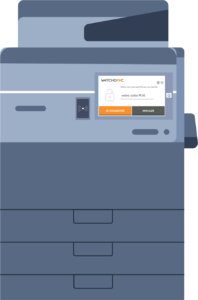In today's digital world, where electronic communication predominates, it's easy to forget the environmental impact of print management processes.
However, controlling printing within your business and encouraging the adoption of more sensible practices can play a vital role in reducing costs, carbon footprints and the inefficient use of resources.
In this article, we'll look at what a print management policy is and why it's important for businesses.
What is a print management policy?
This is a set of rules, guidelines and procedures established within an organisation to manage the use of printers and photocopiers. It aims to optimise printing efficiency, reduce costs and minimise the environmental impact associated with these activities.


What is it for?
There are many advantages. Here are some of the main ones:
- Cost reduction
One of the main reasons why organisations adopt a print management policy is to control their print investment. Excessive and unnecessary printing can lead to unnecessary expenditure on paper supplies, ink cartridges and equipment maintenance. A well-defined policy can set limits on the number of prints allowed, encourage double-sided printing and promote black and white rather than colour printing where possible. By controlling these aspects, companies can make substantial savings.
- Preserving resources :
The print management policy also aims to preserve natural resources and reduce environmental impact. Like any industrial activity, paper production has a significant impact on the environment (cutting down trees, consuming energy to produce and transport paper, and producing polluting waste). By adopting sensible printing practices, organisations can help to protect the environment.
- Increased safety :
A print management policy can also play an important role in strengthening the security of sensitive information. By controlling access to printers and implementing security procedures, organisations can reduce the risk of confidential data leaks. For example, using access codes or badges to release documents directly from the multifunction printer prevents them from being retrieved by the wrong person. These methods also help to limit the number of unrecovered or accidental printouts, thereby reducing waste.
- Raising employee awareness:
A print management policy also provides an opportunity to raise employee awareness of the importance of using resources responsibly. By establishing clear guidelines and communicating the benefits, companies can raise awareness and encourage a culture of environmental responsibility among employees.

In a nutshell
Implementing a print management policy is essential for businesses looking to maximise efficiency, reduce costs and minimise their impact on the environment. By taking steps to control and rationalise printer use, organisations can make significant savings while promoting a sustainable approach to printing.
It also helps to create a responsible corporate culture, where conserving resources and reducing the carbon footprint are priorities.
Let's not forget that adopting environmentally-friendly practices contributes to a more sustainable and responsible future for all.
Would you like to find out more?
The Doxense teams can help you to study and implement your printing policy.
- Initially, we can carry out an audit to study your organisation and usage.
- Then we will identify the levers and validate the hypotheses with a savings calculator.
- Finally, we will suggest the printing policy best suited to your needs.
Find out more about Watchdoc
Print, breathe: find out how Watchdoc can help you simplify your print management while reducing your environmental impact.
Watchdoc is a print management solution that enables businesses to simplify, secure and regulate their operations. Using environmental data and print policies, businesses can change user behaviour and encourage eco-responsible printing habits.
